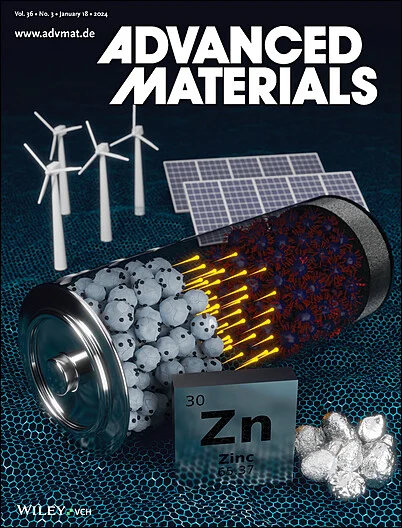Mechanically Enhanced, Environmentally Stable, and Bioinspired Charge-Gradient Hydrogel Membranes for Efficient Ion Gradient Power Generation and Linear Self-Powered Sensing
IF 27.4
1区 材料科学
Q1 CHEMISTRY, MULTIDISCIPLINARY
引用次数: 0
Abstract
The soft hydrogel power source is an interesting example of generating electricity from clean energy. However, ion-selective hydrogel membranes in the systems are often limited by low ion selectivity, high membrane resistance, insufficient mass transfer, and ion concentration polarization, resulting in a generally low power output. Inspired by the unique structure of the electric ray's electric organ, a vertically stacked hydrogel artificial electric organ is proposed, aiming to increase the output current to a greater extent. By constructing the charge gradient in ultrathin ion-selective hydrogel membranes, ion transport is accelerated while mitigating the ion concentration polarization. A single hydrogel artificial electric organ achieves high outputs of ≈290 mV and ≈1.46 mA cm−2 with rechargeability, surpassing similar devices. Density functional theory further reveals that the energy barrier of ion transport in charge-gradient membranes is lower than that in nongradient membranes. More impressively, the device can still be applied as a linear self-powered pressure sensor for monitoring human activities after the ion gradient is completely dissipated. This study elucidates the key role of the structure and design of ion-selective membranes in the artificial gel power generation system, providing new insights into the further development and multifunctional application of flexible gel power source.

求助全文
约1分钟内获得全文
求助全文
来源期刊

Advanced Materials
工程技术-材料科学:综合
CiteScore
43.00
自引率
4.10%
发文量
2182
审稿时长
2 months
期刊介绍:
Advanced Materials, one of the world's most prestigious journals and the foundation of the Advanced portfolio, is the home of choice for best-in-class materials science for more than 30 years. Following this fast-growing and interdisciplinary field, we are considering and publishing the most important discoveries on any and all materials from materials scientists, chemists, physicists, engineers as well as health and life scientists and bringing you the latest results and trends in modern materials-related research every week.
 求助内容:
求助内容: 应助结果提醒方式:
应助结果提醒方式:


